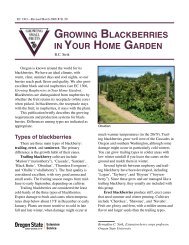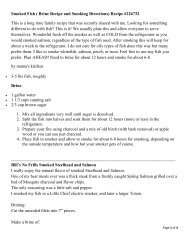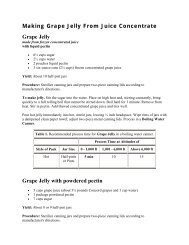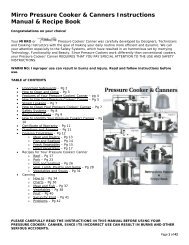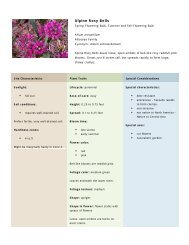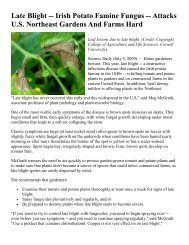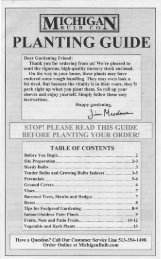Strawberry and Raspberry Pest Management in Wisconsin
Strawberry and Raspberry Pest Management in Wisconsin
Strawberry and Raspberry Pest Management in Wisconsin
You also want an ePaper? Increase the reach of your titles
YUMPU automatically turns print PDFs into web optimized ePapers that Google loves.
Reportable spills <strong>in</strong>volv<strong>in</strong>g SARA substances (see “<strong>Pest</strong>icides <strong>and</strong><br />
Community Right-to-Know,” above) are also to be reported to the<br />
WDEM <strong>and</strong> to your LEPC. To simplify emergency notification<br />
requirements to state agencies, call the WDEM spill hotl<strong>in</strong>e (1-800-943-<br />
0003, 24-hour number) whenever a spill of any compound occurs.<br />
Call<strong>in</strong>g this hotl<strong>in</strong>e will not, however, remove your responsibility of<br />
notify<strong>in</strong>g your LEPC.<br />
Spills of some compounds may require that you notify federal<br />
authorities by call<strong>in</strong>g the National Response Center (1-800-424-8802).<br />
Your call to the WDEM spill hotl<strong>in</strong>e should provide you with assistance<br />
<strong>in</strong> determ<strong>in</strong><strong>in</strong>g whether federal authorities need to be notified.<br />
<strong>Pest</strong>icide fires. In the event of a fire, call the fire department <strong>and</strong> clear<br />
all personnel from the area to a safe distance upw<strong>in</strong>d from smoke <strong>and</strong><br />
fumes. Isolate the entire area. Always <strong>in</strong>form the fire department of the<br />
nature of the pesticides <strong>in</strong>volved <strong>and</strong> of any specific <strong>in</strong>formation that<br />
may help them <strong>in</strong> fight<strong>in</strong>g the fire <strong>and</strong> protect<strong>in</strong>g themselves <strong>and</strong><br />
others from <strong>in</strong>jury. For <strong>in</strong>formation on cleanup <strong>and</strong> decontam<strong>in</strong>ation,<br />
contact the WDEM <strong>and</strong> the pesticide manufacturer(s).<br />
Livestock poison<strong>in</strong>g. When you suspect animal poison<strong>in</strong>g by pesticides,<br />
first call your veter<strong>in</strong>arian. If the cause of poison<strong>in</strong>g cannot be<br />
determ<strong>in</strong>ed, call the WDATCP’s Animal Toxic Response Team at 608-224-<br />
4500.<br />
Wildlife poison<strong>in</strong>g or water contam<strong>in</strong>ation. Contact the WDNR district<br />
office. District offices are located <strong>in</strong> Spooner, Rh<strong>in</strong>el<strong>and</strong>er, Eau Claire,<br />
Green Bay, Milwaukee, <strong>and</strong> Fitchburg.<br />
PESTICIDE DRIFT It is impossible to totally elim<strong>in</strong>ate pesticide drift. Drift occurs because<br />
of unforeseen w<strong>in</strong>d variations <strong>and</strong> other factors, many of which are<br />
beyond the applicator’s control. People liv<strong>in</strong>g <strong>in</strong> areas subject to<br />
pesticide drift worry about the acute <strong>and</strong> chronic effects of exposure to<br />
pesticides. State rules govern<strong>in</strong>g pesticide drift attempt to strike a<br />
balance between the <strong>in</strong>tended benefits of pesticide use <strong>and</strong> the<br />
potential risks to those exposed to pesticide drift.<br />
Accord<strong>in</strong>g to state law, people liv<strong>in</strong>g adjacent to l<strong>and</strong> that is aerially<br />
sprayed with pesticides can request to be notified at least 24 hours<br />
before application. Beekeepers also are entitled to notification of<br />
applications that occur with<strong>in</strong> a 1.5-mile radius of their honey-bee<br />
colonies. Both ground <strong>and</strong> aerial pesticide applications are subject to<br />
advance notification requirements to beekeepers who request such<br />
notification.<br />
For ground applications, you can m<strong>in</strong>imize drift by follow<strong>in</strong>g these<br />
recommendations:<br />
• Follow all label precautions for specific drift-reduction measures.<br />
• Spray when w<strong>in</strong>d speed is low.<br />
• Use the maximum nozzle orifice without sacrific<strong>in</strong>g pest control<br />
activity.<br />
• Keep pressure at the lowest sett<strong>in</strong>g possible without distort<strong>in</strong>g<br />
spray pattern <strong>and</strong> distribution.<br />
• Use drift-control agents when permitted by product label.<br />
• Consider us<strong>in</strong>g nozzles specifically designed to reduce drift.<br />
• Leave an untreated border strip next to adjacent property.<br />
9




